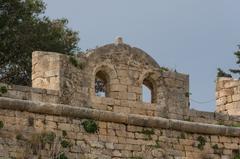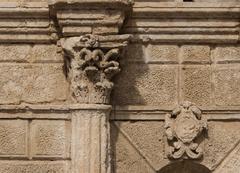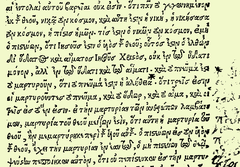Visiting the Contemporary Art Museum of Crete: Rethymno, Greece Guide
Date: 14/06/2025
Introduction
Nestled in the heart of Rethymno’s Old Town, the Museum of Contemporary Art of Crete offers an exceptional fusion of Cretan heritage and dynamic modern artistic expression. Established through the merging of the Municipal Gallery “L. Kanakakis” (1992) and the Centre for Contemporary Art (1995), this museum is dedicated to showcasing Greek contemporary art from the 1950s to the present day. Housed in a beautifully restored Venetian-era building—once a historic soap factory—the museum stands as a testament to the island’s layered history and ongoing cultural vitality (Terrabook; Lonely Planet).
Visitors can explore a permanent collection of approximately 750 works, including key pieces by Rethymnian artist Lefteris Kanakakis, as well as a diverse array of Greek artistic movements—abstraction, neo-expressionism, minimalism, conceptual art, and digital media. Regularly rotating temporary exhibitions and a robust calendar of educational programs make the museum a center for artistic dialogue, both locally and internationally.
This guide provides up-to-date details on visiting hours, ticketing, exhibitions, accessibility, and visitor tips to help you plan an enriching visit to the Museum of Contemporary Art of Crete, while also encouraging exploration of Rethymno’s historic setting (cca.gr; allincrete.com).
Table of Contents
- Historical Evolution of the Museum
- Architectural Significance
- Cultural and Artistic Impact
- Visitor Information
- Permanent and Temporary Exhibitions
- Guided Tours and Educational Programs
- Facilities and Nearby Attractions
- Frequently Asked Questions
- Plan Your Visit
- References and Further Reading
Historical Evolution of the Museum
Origins and Institutional Development
The Museum of Contemporary Art of Crete is the culmination of local efforts to promote modern Greek art. Its roots date to the founding of the Municipal Gallery “L. Kanakakis” in 1992, honoring the prominent local painter. Three years later, the Centre for Contemporary Art was established, expanding the city’s commitment to contemporary cultural initiatives. In 2009, these two institutions merged, forming today’s museum, with a collection that now includes roughly 750 works spanning major movements in Greek art from the 1950s onwards (Terrabook).
The Kanakakis Collection
A significant feature of the museum is its collection of works by Lefteris Kanakakis, a leading figure in Cretan art. Around 50 of his oil paintings, drawings, and watercolors—donated by Babis and Maria Marangos—are on display, offering insight into Kanakakis’s evolving style and broader shifts in post-war Greek art (Terrabook; Lonely Planet).
Architectural Significance
Venetian Heritage and Adaptive Reuse
The museum occupies a Venetian-era building, once one of Crete’s earliest industrial sites—a soap factory. Its robust masonry and historic features are a reminder of Rethymno’s layered past. The municipality acquired the building in 1970, and subsequent restoration transformed it into a cultural landmark, blending old-world character with modern function (Lonely Planet; Terrabook).
Modernization and Features
Restoration efforts have preserved the building’s Venetian architecture while introducing climate control, adaptable exhibition spaces, and accessibility features. This thoughtful design creates a unique setting for the museum’s exhibitions, marrying centuries-old stonework with contemporary display and visitor amenities.
Cultural and Artistic Impact
National and International Recognition
Since its inception, the museum has organized over 100 exhibitions and published more than 60 catalogs. Collaborations with institutions across Greece and beyond have positioned Rethymno as a significant center for contemporary art. Educational programs, guided tours, and workshops for all ages further cement the museum’s role in public engagement and lifelong learning (Terrabook).
Integration with Urban Landscape
Located in the Old Town, the museum is within walking distance of landmarks such as the Venetian Harbour, Fortezza Fortress, and the Archaeological Museum of Rethymno (Lonely Planet). This proximity encourages visitors to experience both the city’s historical and contemporary attractions.
Visitor Information
Location and Accessibility
- Address: 32 Mesologhiou (Messolongiou) Street, Rethymno, Crete, Greece
- The museum is centrally located, easily accessible by foot from major sites, and well-signposted throughout the Old Town.
- The main entrance and key areas are wheelchair accessible; however, the third floor currently is not. For specific needs, it is advisable to contact the museum in advance.
Visiting Hours and Tickets
Summer Season (May 1 – October 31):
- Tuesday – Friday: 09:00–14:00 & 19:00–21:00
- Saturday – Sunday: 10:00–15:00
- Monday: Closed
Winter Season (November 1 – April 30):
- Tuesday – Friday: 09:00–14:00
- Wednesday & Friday: 09:00–14:00 & 18:00–21:00
- Saturday – Sunday: 10:00–15:00
- Monday: Closed
Tickets:
- General Admission: €3
- Reduced Admission: €1.5 (students, children, seniors with valid ID)
- Free admission on certain national holidays and special days (thetinybook.com)
- Tickets are available at the entrance; check the official website for latest updates.
Visitor Tips
- Guided Tours: Available daily (Greek and English); book in advance for groups.
- Workshops: Regular art workshops for all ages, often themed around current exhibitions.
- Photography: Permitted without flash in most areas; check signage for restrictions.
- Best Times: Early mornings or late afternoons are less crowded, especially in summer.
- Nearby Services: Numerous cafes, restaurants, and shops are within walking distance.
Contact Information
- Phone: +30 28310 52530
- Email: [email protected]
- Website: cca.gr
- Educational Programs: 8 Himaras Street, Rethymno | +30 28310 57353 | [email protected]
Permanent and Temporary Exhibitions
The museum’s permanent collection features over 700 works—including paintings, sculptures, photographs, and digital art—that showcase the evolution of Greek art from the 1950s to the present. Thematic and chronological displays allow visitors to trace artistic developments from mid-century abstraction to contemporary conceptual works. Highlights include the Kanakakis collection and pieces by other acclaimed Greek artists (allincrete.com; hellotravel.com).
Temporary exhibitions, curated in partnership with Greek and international organizations, address contemporary themes such as urbanism, identity, and technology. Notable upcoming shows include “What You Wear Is What You Are” (May 17 – Oct 31, 2025), exploring fashion as a vehicle for self-expression.
Guided Tours and Educational Programs
Guided tours tailored for all ages are offered in Greek and English. Educational programs—including workshops in painting, pottery, and art history—are available both at the museum and its dedicated art workroom on Himaras Street. These initiatives foster creative engagement for children, families, and adults, and are often linked to current exhibitions.
Facilities and Nearby Attractions
- Facilities: Cloakroom, accessible restrooms, gift shop, complimentary Wi-Fi, and seating areas.
- Photography: Non-flash photography generally allowed.
- Nearby Attractions: Venetian Fortezza, Archaeological Museum, Old Town shops and cafes.
- Parking: Limited; public transport or central parking lots recommended.
Frequently Asked Questions
Q: How do I purchase tickets?
A: Tickets are sold at the museum entrance; group and guided tour bookings should be arranged in advance.
Q: Is the museum wheelchair accessible?
A: Main floors are accessible; third floor is not. Contact the museum for specific accommodations.
Q: Are guided tours available in English?
A: Yes, guided tours are offered in Greek and English.
Q: Can I take photographs?
A: Non-flash photography is allowed except where signed otherwise.
Q: Does the museum offer programs for children?
A: Yes, with hands-on workshops and tailored tours.
Q: Are there other sites to visit nearby?
A: Yes, the Venetian Fortezza, Archaeological Museum, and scenic Old Town streets are within walking distance.
Plan Your Visit
Allocate 1–2 hours to explore the museum’s exhibitions. Combine your visit with nearby historical sites for a full cultural experience. For the latest updates, events, and digital resources—including virtual tours—consult the official museum website or Lonely Planet.
Enhance your visit with the Audiala app, which provides audio guides, interactive maps, and real-time information on exhibitions and local attractions.
References and Further Reading
- Museum of Contemporary Art of Crete Visiting Hours, Tickets, and Rethymno Historical Sites Guide, Terrabook
- Contemporary Art Museum of Crete: Visiting Hours, Tickets, and Cultural Highlights in Rethymno, CAMC Guide
- Contemporary Art Museum of Crete Visiting Hours, Tickets & Exhibitions Guide, Allincrete
- Contemporary Art Museum of Crete Visiting Hours, Tickets, and Visitor Guide in Rethymno, HelloTravel
- Museum of Contemporary Art of Crete, Lonely Planet


